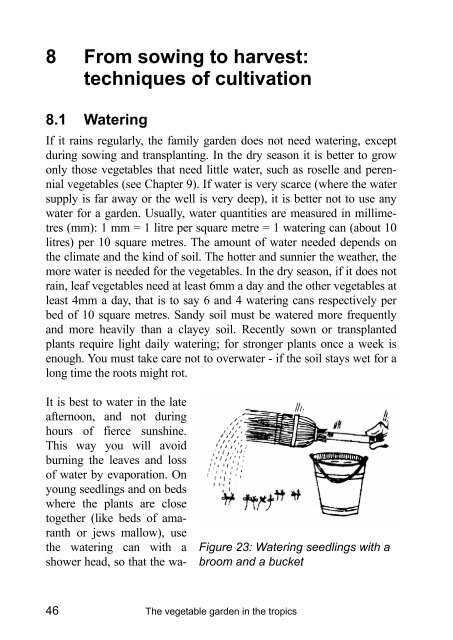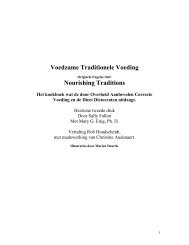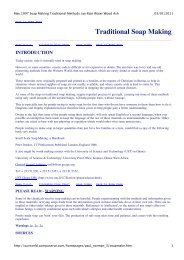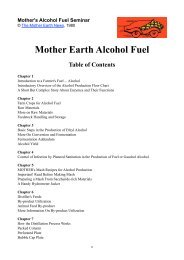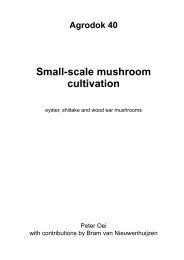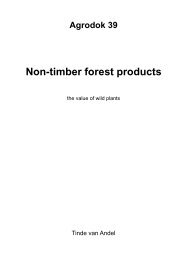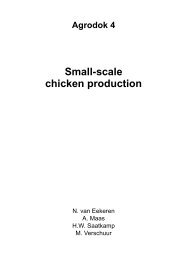The vegetable garden in the tropics - Journey to Forever
The vegetable garden in the tropics - Journey to Forever
The vegetable garden in the tropics - Journey to Forever
Create successful ePaper yourself
Turn your PDF publications into a flip-book with our unique Google optimized e-Paper software.
8 From sow<strong>in</strong>g <strong>to</strong> harvest:<br />
techniques of cultivation<br />
8.1 Water<strong>in</strong>g<br />
If it ra<strong>in</strong>s regularly, <strong>the</strong> family <strong>garden</strong> does not need water<strong>in</strong>g, except<br />
dur<strong>in</strong>g sow<strong>in</strong>g and transplant<strong>in</strong>g. In <strong>the</strong> dry season it is better <strong>to</strong> grow<br />
only those <strong>vegetable</strong>s that need little water, such as roselle and perennial<br />
<strong>vegetable</strong>s (see Chapter 9). If water is very scarce (where <strong>the</strong> water<br />
supply is far away or <strong>the</strong> well is very deep), it is better not <strong>to</strong> use any<br />
water for a <strong>garden</strong>. Usually, water quantities are measured <strong>in</strong> millimetres<br />
(mm): 1 mm = 1 litre per square metre = 1 water<strong>in</strong>g can (about 10<br />
litres) per 10 square metres. <strong>The</strong> amount of water needed depends on<br />
<strong>the</strong> climate and <strong>the</strong> k<strong>in</strong>d of soil. <strong>The</strong> hotter and sunnier <strong>the</strong> wea<strong>the</strong>r, <strong>the</strong><br />
more water is needed for <strong>the</strong> <strong>vegetable</strong>s. In <strong>the</strong> dry season, if it does not<br />
ra<strong>in</strong>, leaf <strong>vegetable</strong>s need at least 6mm a day and <strong>the</strong> o<strong>the</strong>r <strong>vegetable</strong>s at<br />
least 4mm a day, that is <strong>to</strong> say 6 and 4 water<strong>in</strong>g cans respectively per<br />
bed of 10 square metres. Sandy soil must be watered more frequently<br />
and more heavily than a clayey soil. Recently sown or transplanted<br />
plants require light daily water<strong>in</strong>g; for stronger plants once a week is<br />
enough. You must take care not <strong>to</strong> overwater - if <strong>the</strong> soil stays wet for a<br />
long time <strong>the</strong> roots might rot.<br />
It is best <strong>to</strong> water <strong>in</strong> <strong>the</strong> late<br />
afternoon, and not dur<strong>in</strong>g<br />
hours of fierce sunsh<strong>in</strong>e.<br />
This way you will avoid<br />
burn<strong>in</strong>g <strong>the</strong> leaves and loss<br />
of water by evaporation. On<br />
young seedl<strong>in</strong>gs and on beds<br />
where <strong>the</strong> plants are close<br />
<strong>to</strong>ge<strong>the</strong>r (like beds of amaranth<br />
or jews mallow), use<br />
<strong>the</strong> water<strong>in</strong>g can with a<br />
shower head, so that <strong>the</strong> wa-<br />
46<br />
Figure 23: Water<strong>in</strong>g seedl<strong>in</strong>gs with a<br />
broom and a bucket<br />
<strong>The</strong> <strong>vegetable</strong> <strong>garden</strong> <strong>in</strong> <strong>the</strong> <strong>tropics</strong>


